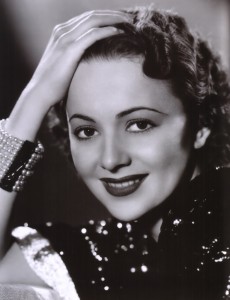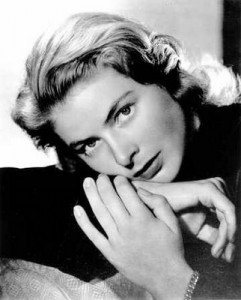There are four actresses I’ve always regarded as what might be called “idealized” beauties, screen ladies who, besides being stunningly beautiful, convey innocence and decency. It’s true: in passing moments, in a certain smile or raised eyebrow, in an occasional atypical role, they can be beguiling or sexy, even wanton, but—and here is where “idealized” comes in—the lingering image is of enchantment and decorum. Inexplicably, these ladies exist in some ethereal world which is intimately their own. With the recent passing of Jean Simmons, by all means one of them, now seems an appropriate time, if belatedly, to honor these women.
Of the four, Olivia de Havilland easily comes the closest to being the innocent, wholesome girl next door, whether in the movies or in real life. Seemingly without effort, she conveys these qualities—in the sparkle of her laugh, the sincerity in her eyes and the clear timbre of her voice, which seems to smile. And numerous films in her career reinforce this image: besides the eight with Errol Flynn, in which she spoke nary a discouraging word, she had many virtuous roles in sometimes sentimental films—Anthony Adverse; Gone with the Wind, her first Oscar nomination (as an almost too-sweet Melanie); Strawberry Blonde, perhaps the epitome of this image, without the concentrated sugar; and Hold Back the Dawn, another Oscar nomination, now as a naïve woman married to a gigolo.
The overt goodness continued in The Male Animal, Princess O’Rourke, To Each His Own—her first Oscar—and the pre-jilted portion of The Heiress. In those scenes with Montgomery Clift in The Heiress, she is the typical goody-goody girl, though plainly made up and acting mousy; after suitor Morris leaves her, going-away luggage and all, abandoned on her father’s doorstep, she turns into an angry, vindictive woman, suddenly mature, the kind of dramatic range Olivia had always wanted—and a second Academy Award she probably also wanted.
Three years earlier, in 1946 in The Dark Mirror, she plays both good and evil twin sisters, a theme Bette Davis later reworked in Dead Ringer. In The Snake Pit—another nomination—Olivia’s versatility was further evident as a mental patient, saved by the compassionate Leo Glenn. Like her sister actress Davis’ struggle for more dramatic fare, Olivia’s was playing off. Hindered by an awkward Richard Burton in his American film début, she was a possible murderess in My Cousin Rachel and the unhappy wife of a willful Robert Mitchum in Not as a Stranger. On the downward slope of her career, The Light in the Piazza and The Proud Rebel are still noteworthy.
But like Davis, when good roles became scarce she went into the horror genre, if not with relish, for that would have been out of character, then out of necessity. This change was suggested in Lady in a Cage, about a woman trapped in the elevator of her home, then threatened by hoodlums.
Olivia and Davis shared a minor triumph in the gothic horror Hush . . . Hush, Sweet Charlotte, recipient of seven Oscar nominations (no wins). Joan Crawford was to play the scheming Miriam Deering, to follow up on the successful Crawford/Davis pairing in Whatever Happened to Baby Jane?, but Joan was taken ill and Olivia, after requesting a rewrite to somewhat humanize her role, agreed to do the part.
Far worse things followed. There was the demeaning TV movie The Screaming Woman and the ridiculous The Swarm, with other equally desperate elderly stars: Fred MacMurray, Henry Fonda, Richard Widmark, José Ferrer, Patty Duke Astin, Slim Pickens and some younger actors who should have known better—Michael Caine, Katharine Ross and Richard Chamberlain. A good laugh was had by all, eh?
Presumably the sparkle of Olivia’s laugh remains, but unfortunately for some years now she has affected a somewhat precious delivery, slow and methodical, weighing each word, as if conscious of posterity. Of these four lovely ladies, only Olivia is still living. With her ninety-third birthday coming July 1, 2010, I wish her the very best.
In 1981, in one of the more outstanding 60 Minutes segments, Harry Reasoner referred to Ingrid Bergman as “licentious and demure.” The Swedish beauty could be either, sometimes both simultaneously, though, more often than not, the viewer is over-persuaded—deceived?—by her beauty. Surely a woman this beautiful wouldn’t, couldn’t—— Yes, there are those moments, but, overall, simply being beautiful and noble seems enough, notably in Casablanca and Spellbound. In Gaslight, innocent and vulnerable.
During the filming of Casablanca, which Ingrid casually regarded as a typical “Hollywood” film, not much more, she was anxious to move on to her next picture, For Whom the Bell Tolls. Here she felt there were more challenges. For one, it was the chance to work with Gary Cooper, and, for another, cutting her hair short for the role of Maria had an appeal, much as Laurence Olivier saw false noses, monocles, wigs, hunchbacks and the like as ways to capture a character’s inner psyche. Similarly, Ingrid wore armor, albeit plastic, in Joan of Arc, and in Dr. Jekyll and Mr. Hyde she preferred Lana Turner’s prostitute role to the one originally planned for her, Jekyll’s upper crust fiancée, which anyone could play, Ingrid felt. The parts were reversed and thus, who is better remembered? Why, of course, the prostitute.
Notorious, at the height of her career, when she was thirty-one, was very much her kind of picture. Already a woman of easy virtue in the opening, she marries a Nazi (Claude Rains) to learn what’s going on in his house in Rio de Janeiro. The chemistry between leading man Cary Grant and Ingrid is phenomenal, even if they are at odds with one another most of the time, with outward animosities and resentments. She, of course, loves him, and as Grant admits at the end, he was “a guy full of pain,” too confused, too afraid to admit his own love. It’s both my favorite Alfred Hitchcock and my favorite Ingrid film.
As Ingrid wasn’t afraid to cut her hair, so she wasn’t afraid, later in life, to play her age and seemed to enjoy the wanton roles. In A Walk in the Spring Rain she has an extra-marital affair, in Goodbye Again a relationship with a young man, in Jean Renoir’s Paris Does Strange Things affairs with two men. Toward the end of her career in Murder on the Orient Express she is shy, dowdy and affects an accent. In her last screen appearance—in this case the small TV screen—she wears her hair in a bun, and even at 67 had to downgrade her resilient beauty to play Golda Meir in A Woman Called Golda.
She won Best Actress Oscars for Gaslight and Anastasia, a Supporting Actress Oscar for Murder on the Orient Express. The Anastasia award was something of a “welcome back, we forgive you, Ingrid” for her return to the United States after seven years in Europe. She had left husband and daughter to live with and later marry Roberto Rossellini. The initial transgression caused outrage in the U.S., even a denouncement from the floor of the Senate, quite amazing now, when Hollywood infidelity and promiscuity are taken in stride and such scandals are more avidly followed than current wars or national financial woes.
On a return to Europe in 1978, Ingrid made Autumn Sonata for Swedish director Ingmar Bergman. She was Oscar-nominated (unsuccessfully) for what some critics say was the best work of her career, easily better than that in Anastasia.
Ingrid’s intractable, independent nature persisted when she learned she had breast cancer. Both British and American doctors insisted she have an operation immediately, but she declared she had other plans and delayed the procedure. The operation was on her birthday and she died from the disease on her birthday seven years later, age 67.
I believe, a hundred years from now, Notorious and Casablanca will be the two films by which she will be best remembered. As for memories, one image of Ingrid stands out above all others, her introduction in Casablanca. Remember? She has just arrived at Rick’s Café and, seated at a table, she asks Sam the piano-player to perform “As Time Goes By.” Was any actress more beautiful than Ingrid at that moment, or more ideally lighted? It makes my heart skip!


classic movies are always source of inspiration for everyone ……….